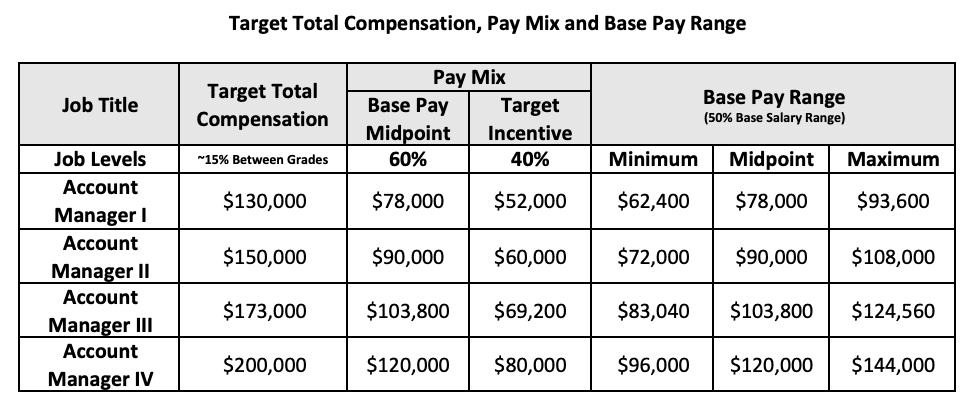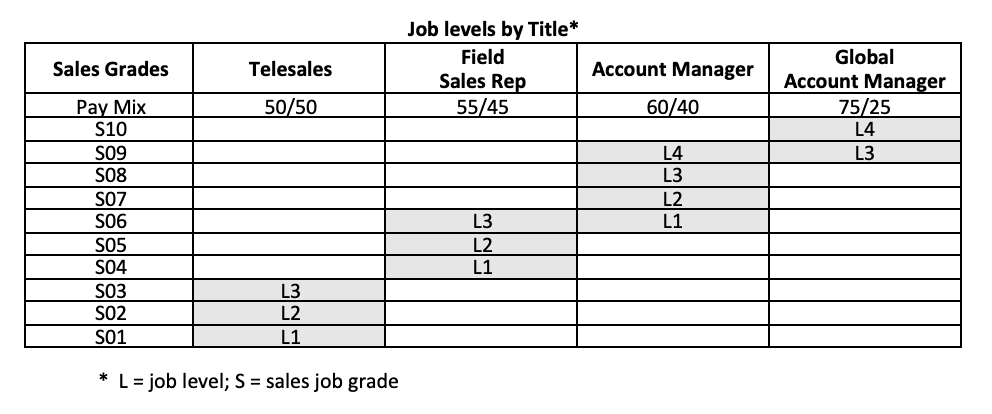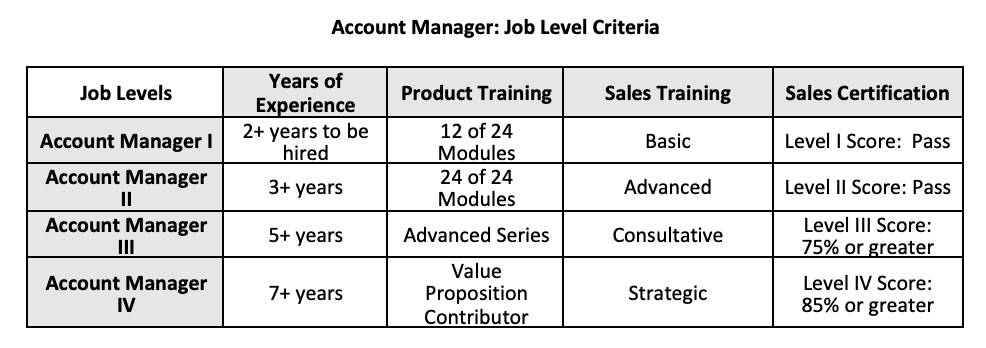Should You Use Job Levels? Yes, but…!
Use Job Levels to Improve the Sales Force Compensation Program!
Job levels offer different target compensation amounts recognizing incumbents’ applied skill levels: entry, career and expert. We will explore why you should use job levels, how to define them and what impact they will have on your sellers’ pay program.
While the incentive element rewards sales outcomes, job levels help recognize seller proficiency. Using job levels is not only a valuable career advancement practice, but an effective pay program technique to reward growing seller competencies; however, they do present challenges.
What Is Job Leveling?
Job leveling is a structured system that defines the expectations, skills and responsibilities for each role in the company. These job roles are then categorized by duties, compensation and career pathways. With a job leveling framework, companies can group similar job types and set comparable qualifications and compensations for every role in the organization.
Human resources (HR) departments and managers use job levels to create career pathways, job hierarchies, and external and internal mobility opportunities. The structure also helps employers build new teams within their organization when expanding. For employees and candidates, job leveling communicates what is expected of them in the role, how that role fits in the broader context and how to earn a promotion.
Benefits of Incorporating Job Levels
Compensation leveling offers these advantages to businesses:
- Career progression opportunities: The leveling structure allows employees to understand the experience, competencies and skills they need to attain before moving to a higher-level position. Management can also identify skill gaps and employees with high potential for the company.
- Talent retention and acquisition: Job leveling can attract qualified candidates to open positions. It can also encourage current talent to stay with a company since they’ll know they have a path forward to develop their career within that organization.
- Alignment with diversity initiatives: The consistency in job descriptions and compensation equality can help a company meet Diversity, Equity, Inclusion and Accessibility (DEIA) requirements and employment practices.
- Consistent expectations: Job levels ensure companies set consistent expectations across their workforce. Employees will understand what is expected of them in their current role and how to progress in the company hierarchy.
- Defined performance standards: Since the job level system defines expectations for the role, it can assist with the performance review process, as both managers and employees will know what the expectations are and whether they’re being met.
- Fair compensation: Job leveling ensures employees are fairly compensated based on their role and may earn more as their job level increases.
Offering increasing levels of target total compensation (TTC) for the same job through multiple job levels provide many benefits:
- Reward progressions: Multiple job levels allow the company to reward sellers as they migrate from neophyte to seasoned sellers. These job level progressions earn promotional increases for incumbents.
- Match market standards: Job levels correctly align with labor market practices offering higher pay for more experienced sales talent.
- Provide internal growth opportunities: Multiple job levels give sellers an in-job career ladder motivating additional learning and seller engagement.
Sales compensation stakeholders can use job levels to foster excellence among the company’s sales talent.
Compensation Leveling Program Context
Compensation programs provide a framework to balance labor market rates, wage inflation and individual performance. The summation of the pay plan elements, like base pay and target incentive earnings, must be market competitive, internally equitable and fiscally responsible. Compensation managers use various tools to balance these pay program objectives.
Market pay surveys are one tool to help identify the target compensation for a job. Meanwhile, pay ranges allow for variance in pay among the incumbents. These pay variances reflect job incumbents’ individual performance and other talent factors, such as professional credentials, training, teamwork and customer impact.
Codes and Designations for Job Grades
Companies use job grades to group jobs of similar target total compensation value. In most companies, corporate/HQ compensation defines job grades, slots jobs and provides an earning opportunity for each job grade. While the jobs within a grade are dissimilar, they share the same target compensation. Most job grades use a code with a letter and a number, such as E12 (exempt job, grade 12) where all jobs within E12 have the same minimum, midpoint and maximum pay range. Expect different job levels for the same job to sit in different job grades.
Sales job grades often have an “S” designation, e.g., S12. While the TTC for jobs slotted into S12 have the same target compensation level, the actual base pay range will vary depending on the job pay mix (base pay/target incentive ratio). Jobs with deep pay mixes (50/50) will have a shallower base pay range than jobs with a pay mix of 80/20.
Types of Pay Ranges and Pay Opportunities
There are two types of pay ranges: base pay and TTC ranges. For base pay ranges, the midpoint is the base pay for the job. When using TTC ranges (base and target incentive), the midpoint is the TTC for the job.
The annual merit increase budget accommodates individual performance and wage inflation. Performance appraisals help determine individual merit pay increases (within the pay range) reflecting personal accomplishments and contributions. The overall merit budget reflects annual increase in labor market rates. The company should provide budget increases to both the base pay and target incentive amounts. Finally, incumbents in high-demand jobs may receive a ”market rate adjustment” or a more generous merit increase opportunity.
Job levels provide different pay opportunities for incumbents performing the same job but reflecting different competency levels. Entry-level folks are paid less, career professionals are paid in the middle and seasoned veterans have the highest earnings potential. Often, a single job grade and pay range do not provide enough earnings opportunities to recognize the increasing levels of seller proficiency. While the sellers are essentially doing the same job, the company needs to offer compensation levels reflecting the level of incumbents’ expertise.
Job Level Titles
Job levels can be numerical (I, II, III, IV) or have different titles. Different titles are the most common practice. Consider the following account manager job level title examples featuring four levels.

Remember, the job content is essentially the same for all job levels. However, the applied expertise of an incumbent elevates the incumbent’s value, thus affecting placement within or promotion to the next level.
How Base Pay Salary Ranges Work
In the following example, notice that the TTC amount for each job level increases 15% from the previous level. (Meanwhile, market-based TTC programs may not feature such mathematical symmetry.) The pay mix of 60/40 (base plus target incentive) is a function of seller-driven buyer influence. The more the seller influence, the higher the pay mix. The less the seller influence, the lower the pay mix.
Most companies use the same pay mix for all job levels of a given job. Some companies use three job levels per job (entry, career, expert), while others may have four, five, six and sometimes seven job levels.
The following example features four job levels for the account manager. To calculate the minimum of the salary range, multiply the base pay midpoint by .80%. To calculate the maximum, multiply the midpoint by 1.20%. This is an example of a “50% salary range” because multiplying the minimum by 150% derives the maximum. Broadband salary ranges are typically much wider with progression from one TTC range to the next greater than 15%. (Some companies do not use ranges, either having a fixed base salary for all incumbents or target amount without a minimum or maximum.)

Job Level Definitions
Job level definitions describe the required applied knowledge for each job level. The incumbent must demonstrate the next level of competency before promotion to that level.
Account Manager Level Definitions
- Level 1: Learning company products, customer applications and internal systems.
- Level 2: Meeting customer needs, solving customer challenges, providing standard pricing.
- Level 3: Guiding customer purchase decisions, negotiating contracts.
- Level 4: Contributing to customer success, offering unique configurations, crafting major contracts.
Job Levels by Title
In the following table, the company can offer one to four job levels per title. Note that telesales and field sales representative jobs use three job levels and only two are used for the global account manager. The account manager job uses all four levels.

Job Level Criteria
Companies may use additional criteria for job level advancement, including quota performance, years of experience, product training, sales training and sales certification. Years of experience are cumulative—reflecting total years of experience. Product training, sales training and sales certification are examples of additional proficiency criteria.

Job Leveling Challenges
The utility of job levels as a pay program is self-apparent: It offers competitive pay levels as sales professionals grow their selling competencies. However, job levels present numerous challenges.
- Administrative Challenge: Defining and maintaining job level definitions and target pay ranges requires ongoing diligence by compensation professionals. Expect changes in customer coverage models. Expect changes in seller job duties. Each change will require corresponding updates to the job level program.
- Market Competitive and Internal Equity Challenge: Job grade slotting and pay ranges require regular monitoring to remain both market competitive and internally equitable.
- Promotion Creep Challenge: With available pay levels awaiting sellers, pressure to promote employees to the next level increases. Promotion creep induces excessive and unwarranted promotions. Similar pressure occurs with experienced hires. The hiring manager may lobby for higher level assignment to secure the new talent. Further investigation will ensure the sales team is meeting management’s DEI (diversity, equity and inclusion) objectives, too.
- Other Program Dependency Challenge: The job level program depends on other programs to work effectively, such as job slotting, pay range calculations, quota system, performance appraisal program, job level definitions and level advancement criteria.
- Geographic Challenge: In some instances, the pay program requires geographic adjustments for both high labor cost areas versus low labor cost areas. If necessary, compensation management will need to provide geographic pay ranges and rules for pay adjustments as personnel move among locations.
Each of these challenges exist, but with strong administrative practices, governance oversight and audit procedures, job levels can operate successfully to retain and grow sales talent.
How to Create a Compensation Leveling System in Your Company
HR managers and upper management often work together to create the company’s compensation leveling system. The job leveling framework should align with business objectives. In creating this system, each role in the company is analyzed to:
- Create coded job levels and titles to demonstrate hierarchy.
- Explain the criteria for career progression.
- Evaluate and define the competencies and duties.
- Assign compensation levels to a pay grade.
Throughout the process, the job leveling creation team can explore the following questions to create a thorough and accurate compensation structure:
- What are the current industry and market trends? Assess the standard job levels and career paths in your industry and their compensation structure. Understanding market trends can help you stand out.
- Is each level of the structure clearly defined? Each job level needs defined skills and knowledge to differentiate it. The definition also gives employees an understanding of why they are at their current level.
- What is our company culture? Each company has a unique organizational culture, which affects career progression. Where small startups may have less hierarchy and fewer job classifications, larger companies will have a more complex structure with several levels.
After the job leveling system is in place, communicate the framework to your team so employees understand their career progression opportunities. Managers can discuss compensation leveling with employees during performance evaluations to explain what skills are required to move up and the responsibilities for their next role.
Contact Alexander Group to Learn More About Job Levels
Job levels offer progressive pay opportunity growth as sellers increase their sales proficiencies. Their benefit outweighs the challenges accompanying these systems. Review your pay opportunities for sellers. You might find virtue in providing a range of earning opportunities to reward applied seller competencies.

Speak With Our Experts
For more information about setting up a compensation leveling structure in your company, contact Alexander Group today.
